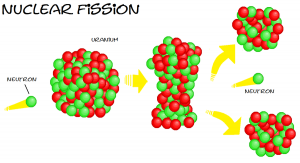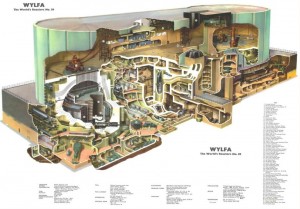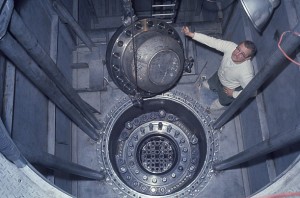Civil nuclear power is electric power generated in a nuclear reactor. Nuclear reactors convert nuclear atomic energy into kinetic energy and heat. Then the generators convert kinetic energy, which is based on movement, into electric energy. I.e. heated water has high movement, and is used to rotate large magnets. A magnetic field there grows and shrinks and this moves electrons in the copper wire placed within that magnetic field. The result is an ‘alternating current’ of electricity in the copper wire.
Most nuclear reactors generate energy by using ceramic uranium dioxide that is contained in metal rods. The reactor produces energy by splitting the uranium atoms, and when most of the uranium atoms have been split, the residual material is removed from the reactor and stored in water pools to displace the heat generated from the waste and to protect employees from the radiation.
Nuclear Fuel
The reactor uses a “nuclear reaction”, splitting apart the atomic bonds to release energy; neutrons smash into the nucleus of the uranium atoms, which split roughly in half, release energy and neutrons in the process. The neutrons ejected can go on to sustain what what we call a chain reaction by the fission of more atomic nuclei.
On a miniscule level inside the fuel we observe an exothermic (exo = giving out; thermic = of heat) chain reaction, producing significant amounts of heat which can be harnessed.
How it Works
The fuel generates heat, then carbon dioxide gas is pumped through the reactor to take the heat away, and this hot gas then heats water to make steam. The steam is pushed through pipes at a pressure strong enough to drive a heavy turbine round, and it’s axle spins a generator in a magnetic field to create electricity for distribution.
The energy conversion is from atomic, to heat, to mechanical, to electrical. Each step in energy conversion involves some dissipation by way of friction etc. with respect to the end purpose, which means that steam power plants will only ever work with an energy efficiency of, at highest 40% regardless of the fuel used.

Modern nuclear power stations use the same type of turbines and generators as conventional power stations.
Nuclear energy:
Pros
- ‘High density’ energy source: produces a million times more energy than fossil fuels due to the tiny size of the nucleus from which the energy is obtained
- Tiny footprint in terms of fuel, technology requirement and land requirement
- Does not create pollutants such as smoke or carbon dioxide
- Produces small amounts of well managed waste
- Reliable, with an average capacity factor of 92%, necessary for ‘base load’ electricity supply
Cons
- Cultural shift is difficult because other methods of generating energy provide more jobs for such as miners and traders due to the high life cycle impact
- Due to public misapprehension and fearmongering, a lot of money has to be spent on meeting strict commissioning, operational & decommissioning safety criteria
- People are put off by high start up cost of new builds, but past the break-even point, they result in a good return on investment
Interesting facts
Nuclear power is generated using Uranium, a metal mined in various parts of the world. The first civil nuclear fission reactor had to be based on uranium-235, because no other fissile material exists in nature.
As an electricity source, civil nuclear power has been viable only in the last 60 years and currently supplies 11% of the world’s electricity needs.
It must be stressed that the process and technology to produce an atomic bomb is now very different from the production of civil nuclear power. Uranium processed for electricity generation is not useable for weapons. Many countries have a civil nuclear programme but no weapons programme.
Yet because first nuclear power plant for electricity in the UK was effectively a by-product from the production of man-made weapons grade materials used in nuclear arms, many people are still mistrustful towards the nuclear industry.
Some military ships and submarines have nuclear power plants for engines.
The People’s Republic of China has initiated a research and development project in the use of thorium fuel instead of uranium, which has potential non-proliferation and economic advantages, despite significant design challenges.


